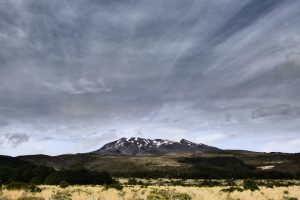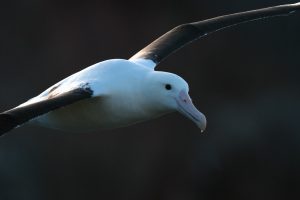The Friendly Fantail
The pīwakawaka, commonly known as the fantail, is a familiar sight in gardens across New Zealand. Science communicator Amy Smith puts forward her case for why these chirruping birds deserve a second term as “Bird of the Year”.
While other common garden birds spend their time in the tree tops, living their lives high above us, pīwakawaka are happy in the leaf litter and low branches below. These cheeky, inquisitive birds were the winner of Bird of the Year in 2006 and are a familiar sight in kiwi gardens. Their friendly “chirruping” is as Kiwiana as pōhutukawa trees at Christmas time
Pīwakawaka are very small. Measuring in at just 16 centimetres, half of their length is accounted for by their tail, giving them the appearance of a tennis ball with wings. Their lack of neck only seems to improve their agility as they duck and weave through the forest. Their two centre-most tail feathers are dark grey, flanked by white and black feathers, giving them a striped appearance. Interestingly, due to a genetic anomaly, one out of every five South Island pīwakawaka have an entirely black tail. Their faces are less cheeky, more grumpy old man thanks to their thick white eyebrows and beard.

Pīwakawaka (Photo by Craig McKenzie).
These little birds are skilled hunters, which only adds to their plump appearance. Accomplished in acrobatics and catching their meals on the wing, they are specially adapted for agility. Their exceptionally long tail feathers allow them them to change direction on a hairpin. Their wings are much shorter than other birds of a similar size, which makes me think pīwakawaka may have sacrificed speed for aerial manoeuvrability.
Pīwakawaka have proven to be unusually resilient to human activity and the introduction of pest species, although they are still at risk from possums and cats, and their eggs especially vulnerable to ship rats. In a single pīwakawaka nest you might find between two and five eggs, so there is a good chance that at least some of them will survive to adulthood. But their relatively healthy numbers may be due in part to how easily they have adapted to the extensive conversion of native bush and scrub, and areas with introduced plants. They are just as happy in a range of habitats – from native bush and forest, to exotic pine plantation, and even in our own backyards.
If you have ever been tramping through the bush you may have noticed a small posse of pīwakawaka following you closely. Footsteps disturb the insects resting in the leaf-litter, giving pīwakawaka the chance of an easy meal. They are not fussy eaters, and eat a variety of insects, moths and spiders. Larger insects are firmly held in their claws and dismembered into manageable sizes leaving behind only the indigestible wings.
Although pīwakawaka are doing okay in New Zealand at the moment, climate change may still affect these little orbs. With milder winters becoming more frequent, their window for nesting and egg-laying may decrease. The emergence of insects may also change, meaning that food may become more scarce at a crucial time of year.
This scenario is not unique to pīwakawaka, as many birds across New Zealand face the same challenges presented by climate change. Substantial change is needed to fight the effects of climate change.
Still, as you vote in Bird of the Year, consider this small but enthusiastic Kiwiana crusader and give your vote to the pīwakawaka.



